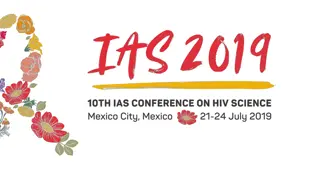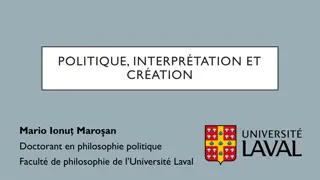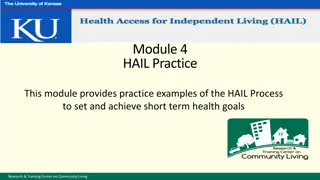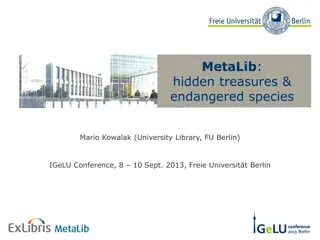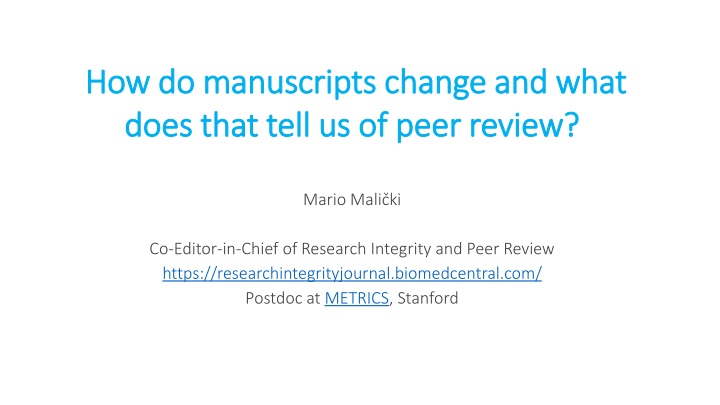
Manuscript Changes and Insights into Peer Review Process
Discover how manuscripts evolve during peer review processes, shedding light on the evaluation of researchers based on their published work. Insights from a comprehensive review of studies analyzing changes in preprints to final journal versions reveal patterns of alterations in content, including background, discussions, analyses, and conclusions.
Download Presentation

Please find below an Image/Link to download the presentation.
The content on the website is provided AS IS for your information and personal use only. It may not be sold, licensed, or shared on other websites without obtaining consent from the author. If you encounter any issues during the download, it is possible that the publisher has removed the file from their server.
You are allowed to download the files provided on this website for personal or commercial use, subject to the condition that they are used lawfully. All files are the property of their respective owners.
The content on the website is provided AS IS for your information and personal use only. It may not be sold, licensed, or shared on other websites without obtaining consent from the author.
E N D
Presentation Transcript
How do manuscripts change and what How do manuscripts change and what does that tell us of peer review? does that tell us of peer review? Mario Mali ki Co-Editor-in-Chief of Research Integrity and Peer Review https://researchintegrityjournal.biomedcentral.com/ Postdoc at METRICS, Stanford
We evaluate researchers most We evaluate researchers most commonly based on their published commonly based on their published papers papers but we don t know how much but we don t know how much of the work was theirs of the work was theirs and how much of the reviewers of the reviewers and how much
Project: Preprint Observatory Project: Preprint Observatory https://data.mendeley.com/datasets/zrtfry5fsd/4 https://data.mendeley.com/datasets/zrtfry5fsd/4 Mario Mali ki, Ana Jeron i , Gerben ter Riet, Lex M. Bouter, IJsbrand Jan Aalbersberg, John P.A. Ioannidis, Steven N. Goodman Disclaimer: Opinions and the presentation are my own These are preliminary results manuscript is still being written
Preparation for the project Preparation for the project Review of 21 studies that analysed changes between preprints or submitted versions to journals vs versions published in a journal (VoR) (studies published till December 2020). (excluded studies that looked at readability scores, accuracy of references or quotations, or abstract changes) 1992 - Wagner E, Middleton P. Effects of technical editing in biomedical journals. JAMA. 2002;287(21):2821-4. - https://doi.org/10.1001/jama.287.21.2821
Brief overview of those 21 studies Brief overview of those 21 studies 16 looked at submitted vs published, 5 preprints vs published 15 looked at changes in Health Sciences manuscripts Md of 62 manuscripts (IQR 42 to 131, min12 max 13,397) Methods: questionnaire filled out for each version (n=9), formula based indices (e.g. number of words, similarity checks)
Brief overview of those 21 studies Brief overview of those 21 studies cont. cont. meta-analysis not possible Overall: background and discussions seem to go through most changes, in 2 studies 20%-30% of manuscripts had additional analyses, up to 30% had changes in conclusions Generalizability low Publication bias potentially high with 45,000-90,000 journals there is a possibility of internal reports.
Our study Our study Objective: To identify changes between epidemiology preprints posted on bioRxiv and their subsequent journal publications. Methods: Till 31 December 2019 there were 1,538 epidemiology preprints posted on bioRxiv. On 5 January 2021, 844 (55%) of those were subsequently published as journal articles, of which 622 (74%) had only one preprint version.
Our study Our study Sample size calculation: Calculator for sample representativeness, with parameters set to 95%CI and 8% margin of error. This yielded a sample size of 121 manuscripts. Random integer set generator (random.org) Outcomes: X will be shown in results Stat. analyses: Descriptive statistics using MedCalc version 19.6.4. Paired t- tests or Wilcoxon test (based on distribution). P<0.05.
Manual Comparison Manual Comparison Compare two versions of a document + counting words, authors, etc. + counting words, authors, etc. MS Word MS Word Compare two versions of a document
Results: Sample Results: Sample 121 bioRxiv preprints later published in a peer reviewed journal 73 different journals (PLOS ONE=20, PLOS Neglected Tropical Diseases=8) 68 in JCR, Md IF 4.0, (IQR 2.9 to 6.9, range 1.5 to 23.6) comparison: In JCR Public, Environmental & Occupational Health - 193 journals Md 2.1 (range 0.2 do 21.6). Published preprints end up in good journals, non-published need to be investigated in other studies
Characteristics Title Preprints Journal articles P (paired test) Title Title Words (M) 15 15 95% CI 14 to 16 14 to 16 0.8458 SD 5 5 Range 5 to 26 5 to 26 31 (26%) of manuscript titles had some changes (e.g., toward to towards, adding or removing the, ) 5 (4%) had more than 3 words (from -5 to +9 words) Mendelian Randomization Analysis Dissects the Relationship between NAFLD, T2D, and Obesity and Provides Implications to Precision Medicine to Causal relationships between NAFLD, T2D and obesity have implications for disease subphenotyping Reporting guidelines + a study type in the title 54 (45%) - included a study / analysis 2 were added in, 1 removed
P (paired test) Journal articles Characteristics Preprints Authorship Authorship No of authors Md 6 6 95% CI 5 to 7 5 to 7 0.0938 IQR 5 to 9 5 to 9 Range 2 to 30 2 to 30 8 (7%) had changes in authorship 5 removed, 2 added, and 1 reordered authors 3 paper included Consortium names (1 was removed) 1 preprint had no authors listed (commented fixed) 16 (13%) had shared authorship (in 1 paper all 6 authors)
How did the abstract content change How did the abstract content change 109 (90%) changed; 29 (24%) only copyediting Background 78 (64%) had changes 44 (36%) copyediting 14 (12%) added new background information Methods 92 (76%) had changes 46 (38%) copyediting 24 (20%) expanded methods; 10 (8%) removed details Results 90 (74%) had changes 37 (31%) copyediting 20 (17%) added (new) results; 7 (6%) had different (P) values Discussion 79 (65%) had changes 40 (33%) copyediting 16 (13%) new conclusions/directions 20 000 to 20,000
Authors Contributions Authors Contributions 44 (36%) preprints vs 91 (75%) journal publications = 47 (39%) new Preprints: 22 ICMJE; 3 CRediT (Contributor Roles Taxonomy); 19 other J. Publications: 35 ICMJE, 41 CRediT; 16 Other Of those that were in preprints 16 (36%) changed ICMJE CRediT LACM contributed to the design of the study, performed the analyses, drafted the initial manuscript, reviewed and revised the manuscript and approved the final version of the manuscript as submitted. Conceptualization: George Davey Smith. Data curation: Louise A. C. Millard. Formal analysis: Louise A. C. Millard. Methodology: Louise A. C. Millard
Introduction Introduction Words: Md=505, +31 106 (88%) changed 67 (55%) expanded literature 37 (31%) altered objectives 20 (17%) copyediting only (Word ranges 170 to 3223)
Methods Methods Words: Md=941, +135 120 (99%) changed 37 (31%) additional analyses 11 (9%) copyediting only + 1 copy. + data availability statement 9 (7%) changes to sample size (Word ranges 103 to 4791)
Results Results Words: Md=804, +79 115 (95%) changed 82 (68%) added (new) or removed some of the results 19 (16%) copyediting only 1 (1%) additional statistical reporting (Word ranges 84 to 4242)
Discussion Discussion Words: Md=1119, +180 116 (96%) changed 65 (54%) added limitations 12 (10%) changed first sentence 11 (9%) copyediting only, 5 (4%) no changes (Ranges 365 to 3320) Our GxE MR-pheWAS of smoking heaviness identified 70 results when ranking on strength of effect in ever smokers, and 8 when ranking on interaction strength. Our GxE MR-pheWAS of smoking heaviness (ranking on interaction strength) identified 12 results, whereas our MR- pheWAS ranking on strength of effect in ever smokers identified 69 results.
References References Journal articles P (paired test) Characteristics Preprints Md=36, +6 102 (84%) changed No of authors Md 95% CI IQR Range 36 42 34 to 42 30 to 48 6 to 131 37 to 47 31 to 52 7 to 133 < 0.0001 Vancouver (1, 2) vs Harward (Author, date) Preprint 111, 10 vs j. publications 102 and 19
Overall Overall Many things can change between publications but what changes do we care about? >117,010,324 million published articles (March 2021, Dimensions.AI) How many of those would need to have undergone significant changes to say that we need peer review? What percentage would you allow to be changed post-publication (i.e. if all was published as preprints)
My Vision for every published paper My Vision for every published paper
Thank you for listening mario.malicki@mefst.hr @Mario_Malicki




